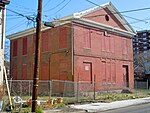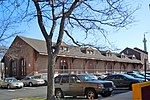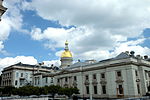Carver Center (Trenton, New Jersey)
African-American fraternities and sororitiesBrick buildings and structuresBuildings and structures in Trenton, New JerseyColonial Revival architecture in New JerseyNational Register of Historic Places in Trenton, New Jersey ... and 1 more
New Jersey Register of Historic Places

The Carver Center, formerly known as the Sunlight Elks Lodge, is a historic Colonial Revival style brick building located at 40 Fowler Street in the City of Trenton in Mercer County, New Jersey. It was named after George Washington Carver, African-American agricultural scientist and inventor. The building was added to the National Register of Historic Places on July 7, 2022, for its significance in ethnic heritage.
Excerpt from the Wikipedia article Carver Center (Trenton, New Jersey) (License: CC BY-SA 3.0, Authors, Images).Carver Center (Trenton, New Jersey)
Fowler Street, Trenton
Geographical coordinates (GPS) Address Nearby Places Show on map
Geographical coordinates (GPS)
| Latitude | Longitude |
|---|---|
| N 40.224722222222 ° | E -74.768611111111 ° |
Address
Carver Youth & Family Center
Fowler Street 40
08618 Trenton
New Jersey, United States
Open on Google Maps








